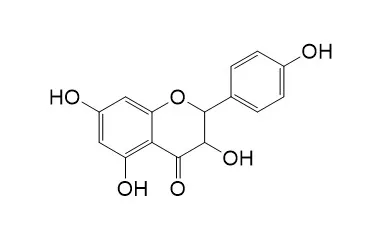| In vitro: |
| Life Sci . 2020 Nov 15;261:118340. | | Dihydrokaempferol (DHK) ameliorates severe acute pancreatitis (SAP) via Keap1/Nrf2 pathway[Pubmed: 32860805] | | Severe acute pancreatitis (SAP) is a non-bacterial inflammatory disease that clinically causes a very high rate of mortality. Dihydrokaempferol (DHK) is a natural flavonoid extracted from Bauhinia championii. Our research aimed to establish the treatment function of DHK on SAP-induced pancreas injury and delve into its potential mechanism. In this study, SAP was induced by caerulein (CER) and Lipopolysaccharide (LPS). DHK was administered orally at different doses of 20, 40, or 80 mg/kg. Results from serum amylase/lipase, pancreas hematoxylin-eosin staining technique, pancreas malondialdehyde (MDA), glutathione (GSH), and reactive oxygen species (ROS) showed the therapeutic effect of DHK in a mice SAP model. MTT revealed DHK alleviated CER + LPS induced cytotoxicity in a dose-dependent manner in the pancreatic acinar cells of mice. Next, we verified DHK suppressed the level of Keap1 and promoted transcriptional activation of nuclear Nrf2 in the presence of CER + LPS. The molecular docking study suggested that there is a potential interaction between DHK and Keap1. To further look at the role of Keap1 using in vitro and in vivo models, Keap1 overexpression adenovirus (ad-Keap1) was performed. The results revealed that ad-Keap1suppressed the nuclear translocation of Nrf2 which is enhanced by DHK, and suppressed the antioxidative functionality of DHK both in mice and cell models. Collectively, this research demonstrated that DHK bettered the SAP induced pancreas injury by regulating the Keap1/Nrf2 pathway and regulating oxidative stress injury. | | Evid Based Complement Alternat Med . 2018 Dec 2;2018:9806160. | | Apoptosis Effects of Dihydrokaempferol Isolated from Bauhinia championii on Synoviocytes[Pubmed: 30622621] | | Bauhinia championii (Benth.) Benth. is a traditional medicinal plant used in China to treat rheumatoid arthritis (RA), especially in She ethnic minority group. This study focused on the active constituents from the rattan of B. championii (Benth.) Benth., which possess potential apoptosis effects. A conventional phytochemical separation method for the isolation of compounds from the ethyl acetate extract of B. championii was developed. The procedure involved extraction, liquid-liquid partitioning with ethyl acetate, and subsequent compound purification, respectively. Additionally, cell viability of Dihydrokaempferol found abundantly in it was evaluated in vitro by MTS, and the antiapoptosis effect was evaluated by annexin V/PI staining (Flow Cytometry Analysis) and western blot. The results showed that nine flavonoids, and five other compounds, were isolated from the ethyl acetate extract of B. championii and were identified as β-sitosterol (1), 5,6,7,3',4',5'-hexamethoxyflavone (2), 3',4',5,7-tetrahydroxyflavone (3), 5,7,3',4',5'-pentamethoxyflavone (4), 4'-hydroxy-5,7,3',5'-pentamethoxyflavone (5), apigenin (6), liquiritigenin (7), 5, 7-dihydroxylcoumarin (8), 3',4',5,7, -pentamethoxyflavone (9), n-octadecanoate (10), lupine ketone (11), dibutylphthalate (12), Dihydrokaempferol (13), and 5,7,3',5'-tetrahydroxy-6-methylflavanone (14). Among these compounds, 5-14 were isolated for the first time from B. championii. In addition, apoptosis effects of abundant Dihydrokaempferol were evaluated in vitro. Dihydrokaempferol exhibited inhibitory effects on the proliferation of synoviocytes. Furthermore, Dihydrokaempferol promoted Bax and Bad expression, as well as the cleavage of caspase-9, caspase-3, and PARP. Meanwhile, it inhibited Bcl-2 and Bcl-xL expression. These findings indicate that Dihydrokaempferol isolated from the ethyl acetate extract of B. championii effectively promotes apoptosis, which is an important process through suppression of apoptotic activity. The results are encouraging for further studies on the use of B. championii in the treatment of RA. | | Am J Chin Med . 2021;49(3):705-718. | | Protective Effect of Dihydrokaempferol on Acetaminophen-Induced Liver Injury by Activating the SIRT1 Pathway[Pubmed: 33657990] | | Acetaminophen (APAP) overdose is the leading cause of acute liver failure (ALF) in the Western world, with limited treatment opportunities. 3,5,7,4[Formula: see text]-Tetrahydroxyflavanone (Dihydrokaempferol, DHK, Aromadendrin) is a flavonoid isolated from Chinese herbs and displays high anti-oxidant and anti-inflammatory capacities. In this study, we investigated the protective effect by DHK against APAP-induced liver injury in vitro and in vivo and the potential mechanism of action. Cell viability assays were used to determine the effects of DHK against APAP-induced liver injury. The levels of reactive oxygen species (ROS), serum alanine/aspartate aminotransferases (ALT/AST), liver myeloperoxidase (MPO), and malondialdehyde (MDA) were measured and analyzed to evaluate the effects of DHK on APAP-induced liver injury. Western blotting, immunofluorescence staining, RT-PCR, and Transmission Electron Microscope were carried out to detect the signaling pathways affected by DHK. Here, we found that DHK owned a protective effect on APAP-induced liver injury with a dose-dependent manner. Meanwhile, Western blotting showed that DHK promoted SIRT1 expression and autophagy, activated the NRF2 pathway, and inhibited the translocation of nuclear p65 (NF-[Formula: see text]B) in the presence of APAP. Furthermore, SIRT1 inhibitor EX-527 aggravated APAP-induced hepatotoxicity when treating with DHK. Molecular docking results suggested potential interaction between DHK and SIRT1. Taken together, our study demonstrates that DHK protects against APAP-induced liver injury by activating the SIRT1 pathway, thereby promoting autophagy, reducing oxidative stress injury, and inhibiting inflammatory responses. |
|






 Cell. 2018 Jan 11;172(1-2):249-261.e12. doi: 10.1016/j.cell.2017.12.019.IF=36.216(2019)
Cell. 2018 Jan 11;172(1-2):249-261.e12. doi: 10.1016/j.cell.2017.12.019.IF=36.216(2019) Cell Metab. 2020 Mar 3;31(3):534-548.e5. doi: 10.1016/j.cmet.2020.01.002.IF=22.415(2019)
Cell Metab. 2020 Mar 3;31(3):534-548.e5. doi: 10.1016/j.cmet.2020.01.002.IF=22.415(2019) Mol Cell. 2017 Nov 16;68(4):673-685.e6. doi: 10.1016/j.molcel.2017.10.022.IF=14.548(2019)
Mol Cell. 2017 Nov 16;68(4):673-685.e6. doi: 10.1016/j.molcel.2017.10.022.IF=14.548(2019)